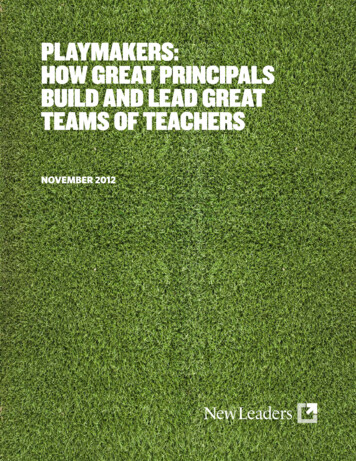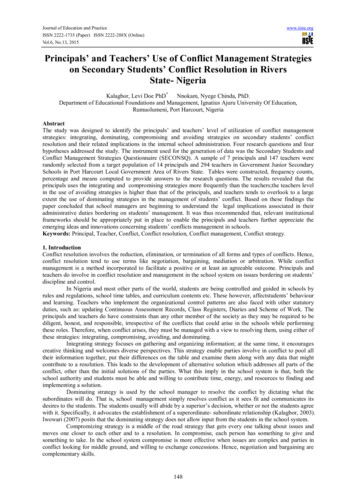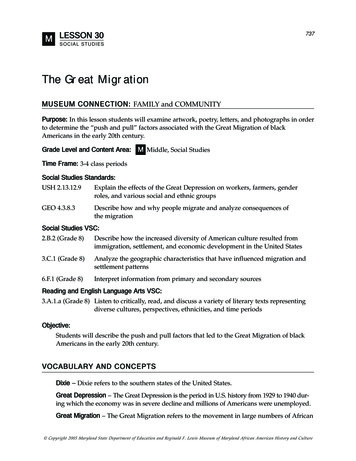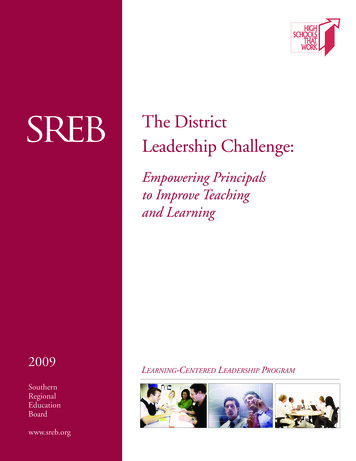
Transcription
PLAYMAKERS:HOW GREAT PRINCIPALSBUILD AND LEAD GREATTEAMS OF TEACHERSNOVEMBER 2012
ACKNOWLEDGMENTSAbout New LeadersNew Leaders has seen first-handthe impact of strong principals inmultiple, diverse communities.Over 12 years, New Leaders hasprepared more than 900 schoolleaders in 12 urban areas acrossthe country. Students in NewLeader schools tend to achieveat higher levels than their peersand tend to have higher highschool graduation rates; some ofour principals have transformedhigh-poverty, under-performingschoolsintoenvironmentswhere teachers and kids canbe their best. New Leaders aremaking measurable progress inclosing the achievement gap.We use the data and insightsgained from our experiencetraining principals and conducting research in high-gainingschools—combined with independent evaluations of our program—to improve our leadershipdevelopment model and to informthe policy recommendations wemake to the field.Contact Us30 West 26th Street, 2nd FloorNew York, NY 1070 2012 New Leaders Inc. All rights reserved.Many individuals across New Leaders made significant contributions to the creation this report. Gina Ikemoto led theanalysis and writing for the report, with significant writingcontributions from Lori Taliaferro and Erica Adams. The reportis based on two research projects, including the Urban ExcellenceFramework research led by Lori Taliaferro and the EffectivePractice Incentive Community (EPIC) case studies led by theEPIC team. Veronica Woolley and Lori Taliaferro conductedanalyses of data for the report, Rebecca Litt and Kay Moffettcontributed to framing and organization, and Amy Norskogcontributed layout and design. The report could not have beencompleted without significant support, input and feedback fromBen Fenton, Stephanie Morimoto and Jackie Gran, who offeredvaluable input at various stages of the study and report writing.We acknowledge the important input received from our formalreviewers, Susan Moore Johnson (Harvard University) and JosephMurphy (Vanderbilt University), who provided thoughtful andinsightful reviews that led us to re-shape some of our findings andto clarify our methods and recommendations. We are also grateful for the candid feedback that we received from Kerri Briggs(George W. Bush Institute), Josh Edelman (Bill and Melinda GatesFoundation), Ed Fuller (Penn State University), Tabitha Grossman(National Governors Association), Ed Pauly and Jody Spiro (TheWallace Foundation), Dan Weisberg (The New Teacher Project)and Courtney Welsh (New York City Leadership Academy). Theirthoughtful comments led to important improvements in theframing and policy recommendations.Finally, we deeply appreciate the principals, teachers, schoolleaders and other staff members who participated in interviewsand shared their valuable time and insights with us.
PLAYMAKERS:HOW GREAT PRINCIPALSBUILD AND LEAD GREATTEAMS OF TEACHERSBY GINA IKEMOTO, LORI TALIAFERRO, AND ERICA ADAMSLeadership on the field:The difference a principal can make . .4The playbook:Three types of plays that principalsmade to amplify great teaching.8Championship coaches:What principals of the mostsuccessful schools did differently.32Rules of the game:Policy recommendations that investresources, time and attention in principals. 38Appendix A:Review of research.44Appendix B:Methodology. 47Appendix C:Summary table of leadership actionsthat amplify teacher effectiveness . . 51Bibliography . 52
LEADERSHIP ON THE FIELD:THE DIFFERENCE APRINCIPAL CAN MAKE4 PLAYMAKERS: HOW GREAT PRINCIPALS BUILD AND LEAD GREAT TEAMS OF TEACHERS
On leadership —“It’s getting the best out of people.”Tom Landry, legendary coach of the Dallas CowboysIconic coaches are remembered for their abilityto take talented individuals and bring themtogether into a well-oiled team with relentlessdrive to succeed. Don Shula demanded perfection, Vince Lombardi exemplified determination and Tom Landry stayed flexible. Greatcoaches invest time and resources in trainingthe talent on the team, make smart choicesabout where and when to play their skill-playersand instill a drive to win. You can’t have achampionship team without a gifted coachbecause teams need leaders.So do schools.It is not surprising that a decade of researchsupports principals’ critical role in shaping thequality of teaching and learning at the school1level. On average, a principal accounts for 25percent of a school’s total impact on studentachievement—significant for a single individual. Indeed, the difference between an averageand an above-average principal can impactstudent achievement by as much as 20 percent2age points. The influence of an individual3principal can be quite substantial, especially inlow-performing schools, where improvement4does not occur without strong leadership.Although principals can impact studentachievement directly, they typically have amore indirect impact by influencing schoolpractices and culture. Recently, research hassuggested that the primary way principals’impact student achievement is by improving5teacher effectiveness. There has been muchdebate in the research over whether principalsimprove teacher effectiveness through management decisions, workplace satisfaction or directefforts to improve instruction. A long traditionof research on instructional leadership arguesthat schools effective in improving studentachievement have principals who focus on cur6riculum and instruction. More recent researchhas found that principals have a substantialeffect on student achievement by structuringhow teachers work together to promote each7other’s learning. Another line of research suggests that the primary means through whichprincipals improve student achievement isthrough hiring, evaluating and removing teach8ers. Yet another argues that principals have themost impact when they create a climate that9improves retention of effective teachers.1e.g., Leithwood et al., 2004; Marzano, Waters & McNulty, 2005. See Appendix I for a thorough review of the literature.2Marzano, Waters & McNulty, 2005.3Branch, Hanushek, & Rivkin, 2012.4Bryk et al., 2010; Louis et al., 2010; Aladjem, Birman, Orland, Harr-Robins, Heredia, Parrish & Ruffini, 2010.5Branch et al., 2012; Louis et al., 2010; Supovitz et al., 2010.6Fink & Resnick, 2001.7Supovitz et al., 2010; Louis et al. 2010.8Rice, 2010.9Chenoweth & Theokas, 2011; Ladd, 2009; Louis et al., 2010. 2012, NEW LEADERS INC.INTRODUCTION 5
Great principals dramaticallyimprove student achievementby developing teachers,managing talent, and creatinga great place to work.No other study has examined the connection between principalsand teacher effectiveness across all of these avenues thoroughlyand in detail. And few have looked at how the relationshipbetween principal leadership and teacher performance variesacross school types and contexts, or at the differences betweenleadership practices that yield incremental gains versus thosethat yield dramatic change. In order to make effective policydecisions, we need to understand the specific, interlocking waysthat principals drive strong teaching. Equally important, weneed to examine the practices that differentiated the highestperforming principals.METHODOLOGYWhile ineffective principalsdrag down the performanceof their schools, effectiveprincipals enable effectiveteaching, at scale, acrossthe whole school.This study addresses gaps in the research by answering the following questions:1. What specific actions do principals of high-performingschools take to improve teacher effectiveness?2. What distinguishes principals of high-performing schoolsfrom other principals?To answer these research questions, we conducted an in-depthanalysis of data sets from two studies conducted by New Leadersfrom 2007 to 2011: the Urban Excellence Framework (UEF)case studies and the Effective Practice Incentive Community(EPIC) case studies. Both data sets were chosen because theyidentify and analyze principals whose schools made betterthan-average gains in student achievement. We refer to theseprincipals across both studies as “highly-effective principals.”The Urban Excellence Framework data set consisted of case studies made during site visits to New Leader schools. The study wasoriginally conducted to determine what leadership and schoolpractices distinguished schools that were obtaining dramaticgains in student achievement from schools that were obtainingincremental gains in student achievement. Dramatic gains weredefined as combined gains in percent proficient in math andEnglish language arts of 20 points or more. Incremental gainswere defined as combined gains in percent proficient in mathand English language arts of 3 to 10 points.6 PLAYMAKERS: HOW GREAT PRINCIPALS BUILD AND LEAD GREAT TEAMS OF TEACHERS
The EPIC data set consisted of case studies of NewLeader and non-New Leader schools that hadrelatively higher value-added scores than otherschools in their district or charter consortium.EPIC is a New Leaders’ initiative that identifiesschools that made the most impressive gains andrewards those school leaders and teachers forsharing the practices that led to the gains. Forboth studies, researchers conducted site visitsand interviews, then coded the informationthey collected according to New Leaders’ UrbanExcellence Framework, which outlines the leadership and school practices that drive dramaticgains in student achievement. This Frameworkincludes the entire range of leadership practices,but for the purposes of this study, we focusedonly on those actions that related to teachereffectiveness. The framework and additionalinformation on the UEF and EPIC studies can befound in Appendix B.We defined the UEF principals who led dramaticgains and the EPIC principals as “highly-effective”or “great” principals because respondents in theseschools attributed their gains at least in part tostrong leadership from the principal. In order toform a clearer picture of the specific ways thesehighly-effective principals influence teaching,we re-examined the case study examples thathad been coded as related to teacher effectiveness according to the UEF framework. As weattempted to organize specific actions from thecase studies into categories that were based on theliterature review (Developing teachers, Managingtalent and Creating a great place to work), werealized that many of the examples served multiple purposes. This led us to organize our findings around the interlocking Venn diagram. Wealso created matrices to examine patterns acrossdifferent types of schools. The methodology isdiscussed in further detail in Appendix B.10 New Leaders, 2009, 2011. The framework is available at /uef/11 Miles & Huberman, 1994. 2012, NEW LEADERS INC.INTRODUCTION 7
THE PLAYBOOK:THREE TYPES OF PLAYSTHAT PRINCIPALS MADE TOAMPLIFY GREAT TEACHING
Great principals amplified great teaching by working in three intersecting areas:1. Developing teachers.2. Managing talent.3. Creating a great place to work.In the following sections, we discuss in detailthe numerous and specific ways the principalsin our study pursued each of these goals,including the ways in which some actionsserved multiple purposes at once (Figure 1).Strong principals seamlessly integrated theirwork to develop teachers with their work tomanage talent and create a great place to work.We found that principals who led the highestgaining schools focused on at least one actionin each of the three areas. They didn’t merelyDevelopingTeachersLeading grouplearning activitiesCreating aprofessionalclimate of sharedaccountabilityfor studentlearningFIGURE 1Principals takeactions to improveteacher effectiveness in threeintersecting areas.go through the motions of developing teachers,managing staff and creating a great place towork. They executed their strategies for improving the quality of teaching in their schools withquality and intensity, while also customizingtheir approach to fit the context of the school.This finding—that the highest gaining schoolshad principals who were explicitly committedto pursuing great teaching in all three areas—has important policy implications. For the sakeStaffing upConductingobservationsw/useful uilding aculture vatingleadershipIndividualizingroles andresponsibilitiesInstituting astudent code ofconductCreating a Great Place to Work 2012, NEW LEADERS INC.THE PLAYBOOK 9
of narration, we will first describe the actionsthe principals in our study undertook in eachof these three areas, painting a vivid pictureof the well-documented claim that principalsdo indeed have an impact on teaching. Wehope the detail contained in this section, “ThePlaybook: Three Types of Plays that GreatPrincipals Made to Amplify Great Teaching”,will help policymakers understand all the typesof actions principals took in the three areas toinfluence teaching in their schools. Later, in thesection called, “Championship Coaches: WhatPrincipals of the Most Successful Schools DidDifferently,” we go into more specifics regarding how the most successful principals strategically utilized the playbook to maximize resultsby simultaneously attending to each section ofthe playbook while also calling the right playsat the right time and executing them flawlessly.In this section, we begin by defining the leadership actions in each area. Actions in the area ofdeveloping staff— such as leading professionaldevelopment, conducting frequent observationsand inspiring teachers to believe that all students can succeed at high levels — were aimedat improving the knowledge, skills and beliefsof teachers. Actions in the area of managingtalent—such as recruiting, selecting, hiringand placing staff—were aimed at obtaining thebest possible teaching staff as well as definingroles and responsibilities to maximize results.Actions in the area of creating a great place towork— such as building a supportive cultureof respect and instituting a student code ofconduct—were aimed at fostering a workplacewhere teachers wanted to stay and grow.Leadership actions (such as observation anduseful feedback) that served multiple areas arediscussed in each area they serve.10 PLAYMAKERS: HOW GREAT PRINCIPALS BUILD AND LEAD GREAT TEAMS OF TEACHERS
DevelopingTeachersHighly-effectiveprincipals workedexplicitly to improveinstruction in theclassroom in theform of conductingobservations andgiving feedback,leading professionaldevelopmentsessions, leadingdata-driveninstruction teamsand insisting on highexpectations forall students.Most principals viewed developing teachers as one of their primaryresponsibilities. The highly-effective principals in our study understoodthat developing staff capacity means both hands-on skill building aswell as nurturing independence and career growth. Highly-effectiveprincipals worked explicitly to improve instruction in the classroomin the form of conducting observations and giving feedback, leadingprofessional development sessions, leading data-driven instructionteams and insisting on high expectations for all students. The principalsalso provided ways for teachers to continuously grow in their careers:they arranged opportunities for staff to learn from one another andthey delegated leadership roles.When developing teachers, principals consistently performed thefollowing actions:DevelopingTeachersLeading grouplearning activitiesCreating aprofessionalclimate of sharedaccountabilityfor studentlearningConductingobservationsw/useful anagingTalentCultivatingleadershipCreating aGreat Placeto WorkEach of these activities are important, but several pay dividendsbeyond just developing teachers; they also help principals manage talent and build a great place to work. In this section, we talk specificallyabout how these actions served to improve the quality of classroominstruction. It is hard to imagine, for instance, instruction improvingin every classroom without a knowledgeable principal willing toengage every teacher in targeted, hands-on instructional support. 2012, NEW LEADERS INC.THE PLAYBOOK 11
Highly-effective principals excelled atgiving teachers feedback throughout theyear—and not only as part of the formalevaluation process. They made it theirmission to know how every member ofthe staff was performing and deliveredfeedback in a way that gave their staff cleardirection and guidance on how to improve.In many schools where the previous principal had not provided feedback on a regular basis, great principalsbuilt a professional culture that established new norms for howprincipals and teachers interacted that emphasized observation forthe purposes of professional growth rather than monitoring andcompliance. Great principals also had to find ways to de-prioritizeother work to make time for observation and feedback. In secondary schools with large numbers of teachers, strong principalstrained and involved their leadership team in carrying out theobservation and feedback process.CONDUCTINGOBSERVATIONSWITH USEFULFEEDBACKProviding teachers withprecise, actionable feedbackon a regular basisWhen Principal Michelle Pierre-Faridstarted at Tyler Elementary Schoolin Washington, D.C., she spenta significant portion of each dayobserving classrooms to understandthe current practices of her teachers and to support their ongoingdevelopment and growth. Whendelivering feedback, Pierre-Farididentified specific aspects of instruction for each teacher to work on,such as the appropriate use of learning centers. She intentionally gaveconcrete feedback to each teacherso that they were able to improvea specific classroom practice orinstructional strategy. For teacherswho needed additional supports, shealso directed staff to a colleague’sclassroom to see specific elementsof good instruction in action.Providing teachers with precise,actionable feedback on a regular basis.Highly-effective principals visited teachers’ classrooms to observeinstruction and provide feedback at least once per month. Whilethe nature of the observations varied from walk-throughs lastingonly a few minutes to observations of entire lessons, the keyingredient for successful classroom observations was the followup. High-performing principals gave specific, timely and actionable feedback that teachers could use immediately to improvetheir practice. Then, they followed up consistently throughoutthe year. Great principals returned regularly to observe teachers’efforts to incorporate feedback and they provided additionalfeedback to continuously respond to evolving skills. They alsohelped teachers to identify other resources to support growthareas, for example, by recommending that teachers attendparticular professional development workshops or observe otherteachers who were particularly strong in the growth area.12 PLAYMAKERS: HOW GREAT PRINCIPALS BUILD AND LEAD GREAT TEAMS OF TEACHERS
LEADINGGROUPLEARNINGACTIVITIESIn addition to individually coaching theirstaff, effective principals also identifiedteam- and school-wide needs for improvement and ensured that their teachersreceived training and professional development that would enable them to succeed.Leading professional development.Highly-effective principals used professional development days strategically. Even when principalsdid not directly facilitate the day, strong principals were deeplyinvolved in planning the content and ensuring that it linked toother school-wide initiatives. In many cases, they were also veryinvolved in running the sessions. Their involvement was criticalbecause they organized sessions in response to the needs they hadwitnessed in their ongoing observations and followed up on thecovered concepts in subsequent observations.Leading data-driven instruction teams.Extensive research has documented the positive impact of datadriven instruction (DDI), in which teachers carefully analyze students’ interim achievement results to diagnose individual, group12and classroom level needs and plan instruction accordingly. Atthe time of these site visits, DDI was a relatively new conceptand many principals found that teachers were not comfortableor skilled in the practice. We found that great principals werealmost always hands-on in leading DDI, particularly during theirfirst year or two in the school. In several cases, principals laterdelegated leadership for this process to others, but only afterthey felt comfortable that teachers understood the process, hadexpertise in data analysis and felt ownership of it.12 Black & William, 1998; Leithwood et al., 2004 2012, NEW LEADERS INC.Leadingprofessional developmetAll new and returning teachersat Higgs, Carter, King Gifted andTalented Charter School in SanAntonio, TX participated in approximately 15 days of professionaldevelopment each August. PrincipalClaudette Yarbrough set the agendaand led much of the training herself.The focus was on school-wide routines for organizing and planninglessons and on classroom management of students. Throughoutthe training, Yarbrough employedtechniques and activities that sheexpected teachers to employ in theclassroom with their students. SaidYarbrough, “In the school’s first several years, I didn’t lead the summertraining. I just planned it. But I sawthat many teachers still didn’t knowwhat was expected of them after thetraining. There had been too muchtelling and explaining during thetraining sessions and not enoughgood teaching. Teachers had beentold what to do, but not shown howto do it. My goal now is to model thekind of teaching we expect to seein our classrooms.” Yarbrough saidthat because she was personallyinvolved, she could, “make sure thatthe teachers know what I expectthem to know. I know what gets saidin the training and what we train on,so I can hold people accountable.The lesson I’ve learned is that I’vegot to be there. I can’t delegate thisto someone else. It is important forme, as the principal, to know whatis going on and to take responsibilityfor making sure it’s done right.”THE PLAYBOOK 13
Leading data-driveninstruction teamsWhen Debra Fox-Stanford becameprincipal at Hamilton ElementarySchool, she discovered that teachers were assessing their studentsusing tests from commercial textbooks that didn’t necessarily alignwith the skills they were teachingweek to week. Fox-Stanford realizedthat this disconnect meant that theteachers did not have an accuratepicture of student progress. Togive teachers’ more useful tools fordetermining whether students werelearning the skills they’re taught,she implemented a cycle of assessment. She led grade-level teams inthe creation of common, short, multiple-choice tests each week andtaught them to use these alignedresults to accurately assess studentprogress and to identify students forsmall-group instruction. Using thisdata, grade-level teams at Hamiltonassessed specific skills and usedthe results to plan re-teaching. SaidFox-Stanford, “Hamilton’s state testscores improved some in spring2008, after we’d begun using common weekly assessments. Scoreswent up even more in 2009. By then,teachers really owned the process.The first year, they started doing itbecause I asked them to. Then theysaw a little increase and startedseeing their kids showing someimprovements.” By the second year,teachers had seen the power ofusing more accurate assessmentsand began to lead data analysiswithin their teams. Through theintensive support in her first year,Fox-Stanford built the capacity andskill of her teacher teams.Exceptional principals built and maintained Teacher Learning Communities inwhich teachers problem-solved together,provided each other with feedback andbuilt a sense of community along the way.Highly-effective principals made consistent time in the day for collaboration,and they developed norms and protocolsthat focused peer observations, feedbackand planning meetings on improving student outcomes. Often,principals were heavily involved in setting up Teacher LearningCommunities, but then encouraged teachers to take moreleadership of learning community activities to enable morepeer-to-peer interaction.FOSTERINGTEACHERLEARNINGCOMMUNITIESThe examples below are components of Teacher LearningCommunities. Either executed separately or as part of a morecomprehensive Teacher Learning Community, these actionsserved to develop and support teachers. However, true TeacherLearning Communities also built a sense of shared identityamong teachers. We later discuss the other components of TeacherLearning Communities in “Creating a great place to work.”Providing time, protocols and an instructional focus tostructure team meetings.Great principals made it possible for grade-level or subject areateachers to meet at a common time during the school day byfinding other coverage for students. During team meetings,teachers provided input and feedback on each other’s lessonplans, used data to inform planning, worked together to troubleshoot and conducted systematic, transparent examinations ofstudent work. Principals offered guidance for how best to usethis time to make a direct impact on instruction. They established protocols to guide group critiques of classroom practices,analyses of student learning across grade levels and across thecurriculum and conversations about expectations, teaching andre-teaching. In addition to being a forum for planning instruction and interventions, the meetings were an opportunity forjob-embedded, peer-centered professional development.14 PLAYMAKERS: HOW GREAT PRINCIPALS BUILD AND LEAD GREAT TEAMS OF TEACHERS
Providing time and protocols to structure peer observation and feedback.Successful principals encouraged teachers to observe each other’s practice and provide eachother with feedback. Such peer observation allows veteran teachers to counsel novices, novicesto observe good teaching and all teachers to share tips and best practices. Principals made peerobservation possible by arranging for substitutes so that teachers could observe a colleague atwork and by creatively using video technology. They also frequently provided standard protocolsfor conducting peer observations and giving feedback, and they made sure teachers felt safe toadmit mistakes and receive feedback from their peers.Providing time, protocolsand an instructional focus tostructure team meetingsPrincipal Tatiana Epanchin-Troyan of MonarchAcademy in Oakland, California establisheda system for grade-level team meetings thatfacilitate meaningful collaboration withinher teacher teams. She realized that havingthe teams analyze their data together set acollegial and supportive environment whereteachers could look to their peers for ideason how to teach content. Their grade levelmeetings, called Data Talks, are structuredconversations during which teachers worktogether to analyze students’ formative andinterim assessment data to track mastery ofcontent and skills.To support high quality conversations thatare driven by data, Principal Epanchin-Troyandeveloped and shared a common set of protocols for analyzing student data and targetinginstruction based on the findings. During theData Talks, teachers are expected to offereach other support in analyzing the data todetermine where the weaknesses are andto give advice on developing strategies toaddress those needs. They also use this timeto give feedback from peer observations.To create time within the school day for regularData Talks to occur, Principal Epanchin-Troyanhired art, music, P.E. teachers and a librarianto supervise students while classroom teachers met in grade-level teams. 2012, NEW LEADERS INC.Providing time and protocols to structurepeer observation and feedbackEileen Callahan, the Dean of Curriculum atBoston Collegiate Charter School in Boston,MA, wanted to give extra support to newteachers in their first year by giving themopportunities to learn through observation.She established a weekly session where newteachers took turns presenting videos of theirteaching. The presenting teacher would complete a written reflection assessing the lessonbefore the presentation and would debriefthe lesson with Callahan during her weeklyone-on-one meeting to choose a particulararea for peer feedback. In the weekly session,observing teachers would watch a video clip ofthe lesson and ask clarifying questions, offerareas of strength and specific suggestionsfor improvement. These questions providedguidance to Callahan in her support of theobserving teachers, while also giving first-yearteachers many opportunities to see teachingin action and to analyze what works.THE PLAYBOOK 15
CREATING APROFESSIONALCLIMATEOF SHAREDACCOUNTABILITYFOR STUDENTLEARNINGRaising expectationsAt Clara Barton School, a historicallylow-performing, 800-pupil PreK-8school in Chicago, Principal TerryCarter was able to boost confidenceand demonstrate that high levelsof student achievement were possible and attainable by showingskeptical staff members’ videos ofschools with similar students thathad succeeded. This challenged theteacher’s perception of the studentsand helped to inspire a sense of possibility and hope within Clara Barton.Improving cultural competencyPrincipal Jennifer Garcia at AspireCentennial College PreparatoryAcademy in Los
About New Leaders New Leaders has seen first-hand the impact of strong principals in multiple, diverse communities. Over 12 years, New Leaders has prepared more than 900 school leaders in 12 urban areas across the country. Students in New Leader schools tend to achieve at hi










